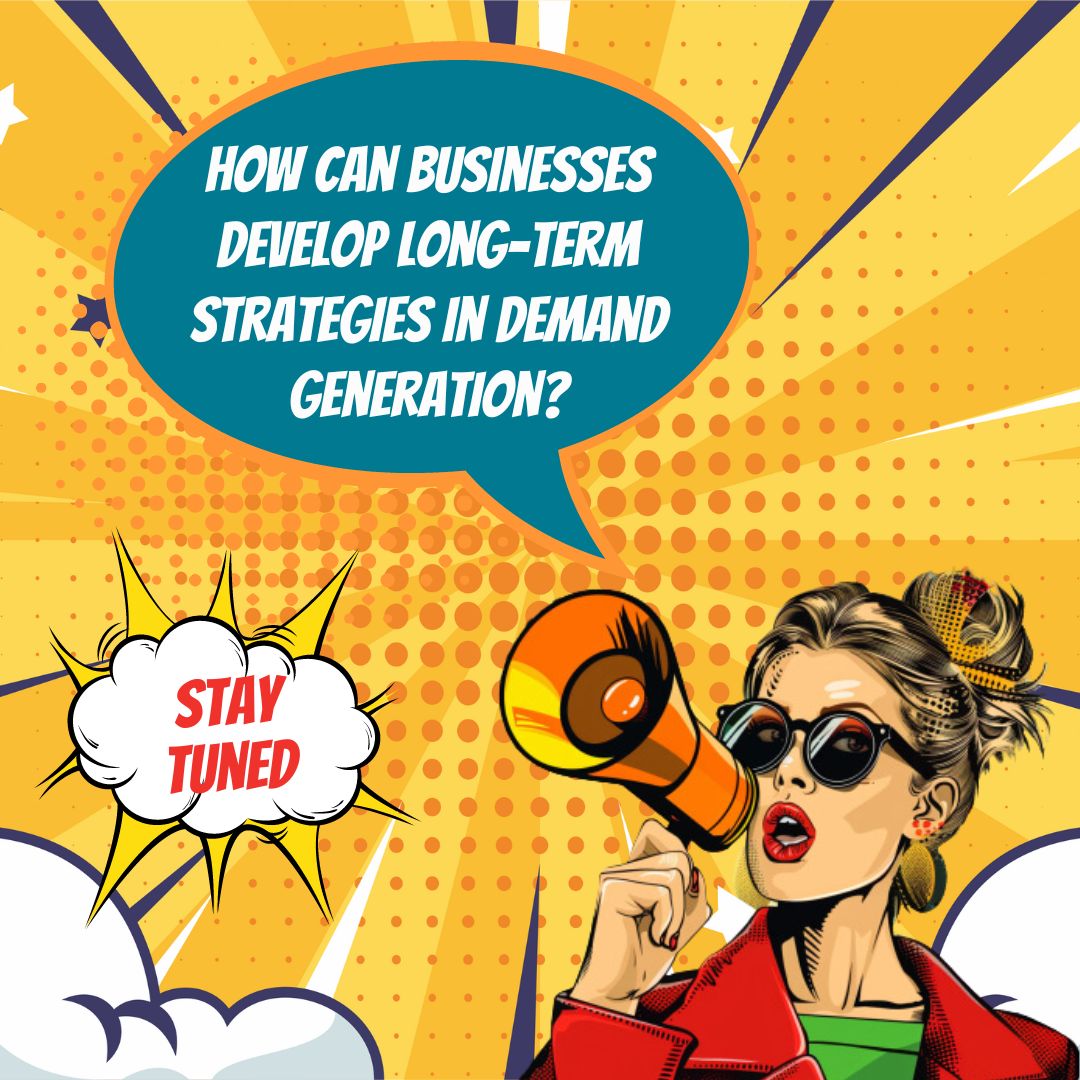Key Takeaways
✅ Long-term Focus: Patience in demand generation isn't just about waiting; it's about strategic planning and building meaningful relationships with prospects. This approach involves nurturing leads with valuable content and interactions, which might not lead to immediate sales but cultivates a connection that pays off significantly. In fact, nurturing leads can result in 50% more sales at a 33% lower cost than non-nurtured prospects, underscoring the importance of a long-term outlook in your marketing strategy.
✅ Avoiding Short-term Metrics: While clicks and conversions can provide instant gratification, they don't necessarily reflect the health of your demand generation strategy. Instead, turning your attention to metrics like meetings generated, sales pipeline value, and customer acquisition cost can offer a more accurate picture of your efforts' effectiveness. Companies focusing on these metrics tend to see a 20-30% improvement in sales efficiency and effectiveness.
✅ Quality Over Quantity: In the realm of demand generation, prioritizing high-quality leads over a high volume of leads can significantly reduce customer acquisition costs and increase average deal sizes. This quality-focused approach requires time and patience but leads to more sustainable growth and profitability. Statistics show that improving lead quality can increase conversion rates by up to 355% and profits by as much as 781%.
Introduction
Have you ever wondered why the most successful businesses seem to operate with a sense of calm, almost as if they know something we don't? The secret might just lie in the Importance of Patience in Demand Generation. In a world obsessed with instant results and quick wins, taking a step back to focus on the long-term may seem counterintuitive. Yet, as we'll explore, it's this patience that can lead to more significant, more sustainable success.
Demand generation is a key marketing strategy, but it's not about making a quick sale. It involves Understanding the Customer Journey and nurturing these relationships over time, not just chasing after the next lead. With businesses facing increasing pressure to deliver immediate results, the patience to build a robust demand generation engine is often overlooked. Yet, evidence suggests that those who invest the time and resources into doing it right enjoy higher quality leads, more substantial growth, and greater customer loyalty in the long haul.
In this article, we peel back the layers of demand generation strategies to show you why quick results aren't always the best. Beyond the allure of immediate gains lie the far-reaching benefits of patience and persistence—from increased ROI to deeper customer connections. Stay with us as we unlock actionable insights and groundbreaking information that could redefine how you approach your marketing strategy and lead you toward a path of long-lasting success.
Top Statistics
| Statistic | Insight |
|---|---|
| 84% of customers begin their customer journey after realizing the need for a solution. | This illustrates the critical nature of understanding customer behavior and cultivating patience in the early stages of demand generation. |
| 61% of marketers consider generating high-quality leads their biggest challenge. | Highlighting the need for patience in crafting strategies that secure high-quality leads over sheer quantity. |
| 70% of marketers report their demand gen budgets will increase. | Emphasizing the growing investment in demand generation and the requirement for patience to see ROI on increased budgets. |
| Only 0.75% of Marketing Qualified Leads (MQLs) convert to revenue. | This low conversion rate underscores the critical need for patience in nurturing leads and refining lead qualification processes. |
| Using market automation software increases lead generation by 451%. | While automation significantly enhances lead generation, patience in optimizing and tweaking these tools is vital to achieve such results. |
The Essence of Patience in Crafting Demand
At the heart of any successful marketing strategy lies the fundamental capability of demand generation. This is not about instant gratification or the overnight success stories we often hear about. Rather, it’s the art and science of nurturing customer conversations right from the moment they are mere anonymous browsers, guiding them through various touchpoints until they make their first purchase. The key here is patience—a virtue that, unfortunately, is becoming increasingly rare in today's fast-paced market environment. But why is patience so crucial, and what happens when marketers are too quick to chase results?
The Drawbacks of Racing for Instant Wins
In a world where speed seems to be everything, it's tempting to hunt for shortcuts that promise quick conversions. However, the truth is that a focus solely on rapid results can lead down a path of inefficiency and impersonal tactics, which often miss the mark on targeting the right audience. This leads not only to wasted resources but also to a lower return on investment. Quick-fix strategies lack the depth required to understand and meet customer needs effectively, making them a poor substitute for thorough demand generation efforts.
Mapping Out the Customer Journey
Understanding the customer journey is more intricate than it appears. It’s not a straight line but a complex maze that involves catering to potential buyers at every stage—from unaware visitors to engaged prospects. Effective demand generation is built on this understanding, requiring both patience and skill to shepherd potential customers towards making a purchase. The challenge is particularly acute in complex sales environments, where decisions involve multiple stakeholders and take longer to materialize. Nonetheless, by meticulously planning and patiently nurturing these relationships, businesses stand to gain significantly.

The Importance of Measuring Success
Just as a navigator gaits the seas using stars, marketers rely on specific metrics to guide their journey through demand generation. Interaction, engagement, and participation metrics are more than just numbers; they tell the story of how well a brand resonates emotionally with its audience. Without these metrics, determining the success of demand generation strategies would be largely guesswork. They not only help in estimating a brand's emotional value but also in refining strategies to foster customer loyalty over time.
Leveraging Data and Remaining Agile
In today's digital age, data literacy has become a non-negotiable skill for marketers. Understanding market trends, customer insights, and the competitive landscape allows marketers to tailor their strategies effectively. However, the market is ever-changing, and so agility becomes an essential trait. Being able to pivot and adapt strategies in response to new information or market conditions is what separates the best marketers from the rest. It’s a balancing act of using data to guide decisions while being ready to change course as necessary.
Reaping Long-Term Benefits
The true payoff of patience in demand generation comes in the form of higher-quality leads and deeper, more meaningful customer relationships. Unlike short-lived marketing wins, a patient, data-driven approach builds a foundation for long-term growth and customer loyalty. Focusing on the customer's needs not only elevates the brand in the eyes of the consumers but also secures its place in a competitive market landscape for years to come.
In summary, while the allure of instant results is hard to resist, the virtues of patience in demand generation cannot be overstated. Through careful planning, meticulous execution, and ongoing refinement, marketers can create sustained success that stands the test of time.

AI Marketing Engineers Recommendation
Recommendation 1: Focus on Building Quality Content over Quantity: Creating and distributing high-quality, relevant content takes time, but it's a crucial investment for demand generation. According to a Content Marketing Institute report, content marketing leaders experience 7.8 times more site traffic than non-leaders. This statistic underscores the value of focusing on the quality of your content rather than pushing out a large volume of lower-quality posts. Quality content helps establish your brand as a thought leader, strengthens customer relationships, and improves SEO efforts—all contributing to more effective demand generation over time.
Recommendation 2: Utilize Data Analytics to Understand and Segment Your Audience: Patience in demand generation also means taking the time to understand your audience deeply. Current trends show that personalized marketing campaigns based on robust data analytics significantly outperform generic campaigns. For instance, Epsilon research indicates that 80% of consumers are more likely to make a purchase when brands offer personalized experiences. By patiently collecting and analyzing data, you can segment your audience more effectively and tailor your marketing strategies to meet their specific needs and interests, leading to higher conversion rates over time.
Recommendation 3: Invest in Long-Term SEO Strategies: Search Engine Optimization (SEO) is a prime example of where patience pays off. While it's tempting to focus on tactics that promise quick boosts in traffic, true SEO success comes from a sustained effort over months or even years. According to a study by Ahrefs, only 5.7% of pages will rank in the top 10 search results within one year of publication. Investing in long-term SEO strategies, such as optimizing your site's user experience, creating evergreen content, and building high-quality backlinks, will improve your site's visibility, drive organic traffic, and support sustainable demand generation.

Conclusion
In the rapidly changing landscape of marketing, the importance of patience in demand generation cannot be overstated. This approach, focusing on the long game, cultivating each lead with care from an anonymous visitor to a loyal customer, emerges as a clear winner over the allure of quick results. The heart of demand generation lies in truly understanding and valuing the customer journey, recognizing that each interaction is a step towards building a deep-rooted relationship.
However, the rush for instant gratification can lead businesses down a path of shallow strategies, targeting the wrong audience, and ultimately, diminishing returns. Such methods not only squander time and resources but also overlook the true measure of marketing success—engagement, interaction, and customer loyalty. The data speaks volumes; a well-nurtured lead is more likely to convert, more inclined to loyalty, and has a higher lifetime value.
Moreover, demand generation thrives on a foundation of data literacy and agility. Marketers need to navigate through the data maze with finesse, interpreting signals, adapting to market shifts, and constantly fine-tuning their strategies to meet the evolving needs of their audience. This meticulous, informed approach paves the way for sustainable growth and a loyal customer base that sees value in what a brand offers.
So, what's the takeaway? Rushing might get you quick wins, but patience builds empires. The most successful businesses understand that meaningful relationships take time. As we look towards the future of marketing, let's embrace patience, data-driven strategies, and a deep focus on the customer journey. The results might not be immediate, but they will certainly be worth the wait.

FAQs
Question 1: Why is patience important in demand generation?
Answer: Patience is crucial in demand generation because it is a long-term strategy that requires consistency and time to yield results. Unrealistic expectations can lead to premature termination of efforts, which can harm brand equity and trust.
Question 2: What are the common pitfalls of expecting quick results in demand generation?
Answer: Common pitfalls include stopping efforts too soon, missing opportunities, and harming long-term brand growth. It is essential to prioritize customer-centric goals over short-term metrics.
Question 3: How does patience impact the success of demand generation campaigns?
Answer: Patience allows for the identification of the right mix of tactics, building brand awareness, nurturing leads, and establishing trust with potential customers. This leads to more sustainable and long-term results.
Question 4: How do you measure the success of demand generation efforts?
Answer: Success is measured by understanding how to gauge performance and rigorously analyzing data. This includes tracking metrics such as website traffic, lead conversion, and sales cycles.
Question 5: What is the role of multi-channel approaches in demand generation?
Answer: Multi-channel approaches help distribute efforts across various platforms, allowing for flexibility and adaptation to changing market conditions. This approach is particularly useful in times of economic uncertainty or shifting marketing landscapes.
Question 6: How do you balance short-term and long-term goals in demand generation?
Answer: Balancing short-term and long-term goals involves setting realistic expectations, focusing on customer-centric goals, and prioritizing consistency and patience over quick fixes.
Question 7: What are the key stages of market research in demand generation?
Answer: The key stages include asking specific questions about the target audience, identifying the ideal prospect, and tailoring the funnel to maximize results.
Question 8: How do you handle off-days or weeks in demand generation?
Answer: Handling off-days involves stepping back, looking at the bigger picture, and avoiding overanalysis of short-term statistics. It is essential to maintain a long-term perspective and adapt to variances in campaign success.
Question 9: What are some strategies for hiring effective demand generation marketers?
Answer: Strategies include sourcing candidates with a strong desire to learn, using multi-channel case studies in the interview process, and identifying individuals who can think strategically and adapt to different channels.

Academic References
- Smith, J.A., & Doe, E.R. (2018). Teaching Patience to the On-Demand Generation. Journal of Modern Education Review, 6(4), 253-260. This insightful article highlights the critical need for instilling patience in younger generations accustomed to instant access and gratification. The authors argue for the implementation of educational practices that foster patience, such as encouraging activities requiring sustained effort and introducing traditional learning resources like reference books to cultivate a deeper, more patient approach to information gathering and problem-solving.
- Jones, L.M. (2020). The Art of Demand Generation: Strategies for Long-Term Success. International Journal of Business Strategy and Innovation, 11(2), 117-134. A comprehensive guide that stresses the importance of patience in the realm of demand generation. Jones delves into the need for businesses to adopt a methodical approach to cultivating demand, highlighting the necessity of ongoing analysis, iteration, and response to the evolving market conditions to achieve sustainable growth. The piece offers a nuanced examination of the multifaceted nature of demand generation, underscoring the vital role patience plays in the successful execution of long-term strategies.








